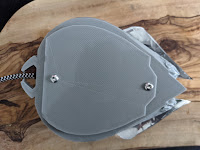/////////////////////////////////
// Space Beetle //
// By Julia Houha //
////////////////////////////////
///////////////////////////////////////////////////////////////////
// Instructions: //
// Jump: Space / Both Wings //
// Speed: W / Tilt Up //
// Left Slide: A / Tilt Left + Left Wing //
// Right Slide: D / Tilt Right + Right Wing //
///////////////////////////////////////////////////////////////////
///////////////////////
// Libraries //
//////////////////////
#include <Keyboard.h>
#include <Adafruit_CircuitPlayground.h>
#include <Adafruit_Circuit_Playground.h>
///////////////////////
// Variables //
///////////////////////
// Create turn int
const int debounce = 100;
const int threshold = 500;
bool jumping = false;
bool sliding = false;
bool zooming = false;
float Lforce = 0.0;
float Rforce = 0.0;
bool leanL = false;
bool leanR = false;
const int lFSR_PIN = A2; // left FSR pin
const int rFSR_PIN = A3; // right FSR pin
const float VCC = 3.27; // input voltage
const float R_DIV = 9930.0; // resistor
////////////////////////////////
// Keyboard Map //
///////////////////////////////
void setup() {
Serial.begin(9600);
CircuitPlayground.begin();
//Keyboard Inputs
pinMode(CPLAY_SLIDESWITCHPIN, INPUT_PULLUP); // failsafe for infinite loop
pinMode(CPLAY_LEFTBUTTON, INPUT_PULLDOWN); // placeholder left force sensor
pinMode(CPLAY_RIGHTBUTTON, INPUT_PULLDOWN); // placeholder right force sensor
pinMode(lFSR_PIN, INPUT); // left FSR
pinMode(rFSR_PIN, INPUT); // right FSR
Keyboard.begin();
}
// Loop
void loop() {
// Failsafe Switch
if (!digitalRead(CPLAY_SLIDESWITCHPIN)) {
Keyboard.releaseAll();
//Serial.println("released all keys");
}
if (sliding == false) {
Keyboard.release('A');
Keyboard.release('D');
}
// Space Inputs
if (jumping == false && leanL == true && leanR == true) {
Keyboard.press(' ');
jumping = true;
}
if (jumping == true && leanL == false || leanR == false) {
Keyboard.release(' ');
jumping = false;
}
slideX();
zoomY();
// LEFT FSR reading
int LfsrADC = analogRead(lFSR_PIN);
if (LfsrADC != 0) {
float LfsrV = LfsrADC * VCC / 1023.0;
float LfsrR = R_DIV * (VCC / LfsrV - 1.0);
//Serial.println("Left Resistance: " + String(LfsrR) + "ohms");
Lforce;
float LfsrG = 1.0 / LfsrR;
if (LfsrR <= 600)
Lforce = (LfsrG - 0.00075) / 0.00000032639;
else
Lforce = LfsrG / 0.000000642857;
Serial.println("Left Force: " + String(Lforce) + " g");
Serial.println();
//delay(500);
}
// RIGHT FSR reading
int RfsrADC = analogRead(rFSR_PIN);
if (RfsrADC != 0) {
float RfsrV = RfsrADC * VCC / 1023.0;
float RfsrR = R_DIV * (VCC / RfsrV - 1.0);
//Serial.println("Right Resistance: " + String(RfsrR) + "ohms");
Rforce;
float RfsrG = 1.0 / RfsrR;
if (RfsrR <= 600)
Rforce = (RfsrG - 0.00075) / 0.00000032639;
else
Rforce = RfsrG / 0.000000642857;
Serial.println("Right Force: " + String(Rforce) + " g");
Serial.println();
//delay(500);
}
// Setting left and right leans
if (Lforce > 300) {
leanL = true;
} else
leanL = false;
if (Rforce > 300) {
leanR = true;
} else
leanR = false;
}
// Slide
void slideX() {
float x = CircuitPlayground.motionX();
// map to accelerometer for left or right slide
int slide = map(x, -10, 10, -3, 3);
// left slide when rotated left with left button pressed
if (sliding == false && slide == 2 && leanL == true) {
Keyboard.press(' ');
Keyboard.press('A');
//delay(debounce);
Serial.println("sliding left");
//Serial.println(slide);
sliding = true;
}
if (sliding == true && leanL == false) {
Keyboard.release(' ');
Keyboard.release('A');
//delay(debounce);
//Serial.println("stopped sliding");
//Serial.println(slide);
sliding = false;
}
// right slide when rotated right with right button pressed
if (sliding == false && slide == -3 && leanR == true) {
Keyboard.press(' ');
Keyboard.press('D');
//delay(debounce);
Serial.println("sliding right");
//Serial.println(slide);
sliding = true;
}
if (sliding == true && leanR == false) {
Keyboard.release(' ');
Keyboard.release('D');
//Serial.println("stopped sliding");
sliding = false;
}
if (slide == 1 && leanL == false) {
Keyboard.press('A');
}
if (slide == -1 && leanR == false) {
Keyboard.press('D');
}
}
// Flap
void zoomY() {
float y = CircuitPlayground.motionY();
// map to accelerometer for zoom
int zoom = map(y, -10, 10, -3, 3);
// zoom when pointed down
if (zooming == false && zoom >= 2) {
Keyboard.press('W');
zooming = true;
}
if (zooming == true && zoom <= 1 || leanL == true || leanR == true) {
Keyboard.release('W');
zooming = false;
}
}











